Customer Service Management and CRM Model for The Pig Hotels
VerifiedAdded on 2020/12/26
|12
|3728
|413
Report
AI Summary
This report provides a comprehensive analysis of Customer Relationship Management (CRM) within the context of the tourism and hospitality industry, using The Pig Hotels as a specific case study. The introduction defines customer service management and its role in enhancing customer relationships and driving sales growth. Task 1 delves into the different components of the CRM model, such as Sales Force Automation, Human Resource Management, Lead Management, Customer Service, Marketing, Workflow Automation, and Business Reporting, and how they contribute to building strong customer relationships. It also highlights the importance of CRM as a business strategy and the need for varied approaches within the hotel sector. Task 2 focuses on the values created by the CRM model, particularly in the context of The Pig Hotels, and examines the building blocks of the Gartner CRM model, including vision, strategy, customer experience, and organizational collaboration. The report emphasizes the significance of customer segmentation, building customer portfolios, and adapting operational activities to improve customer service. It concludes by highlighting the importance of good and ethical practices in the hospitality sector, such as face-time focus and staff happiness, to achieve customer satisfaction and business objectives. The report provides a detailed overview of CRM implementation, its benefits, and its practical application in the hospitality industry, specifically focusing on the strategies and practices of The Pig Hotels.

Customer Service Management
for Tourism and Hospitality
for Tourism and Hospitality
Paraphrase This Document
Need a fresh take? Get an instant paraphrase of this document with our AI Paraphraser
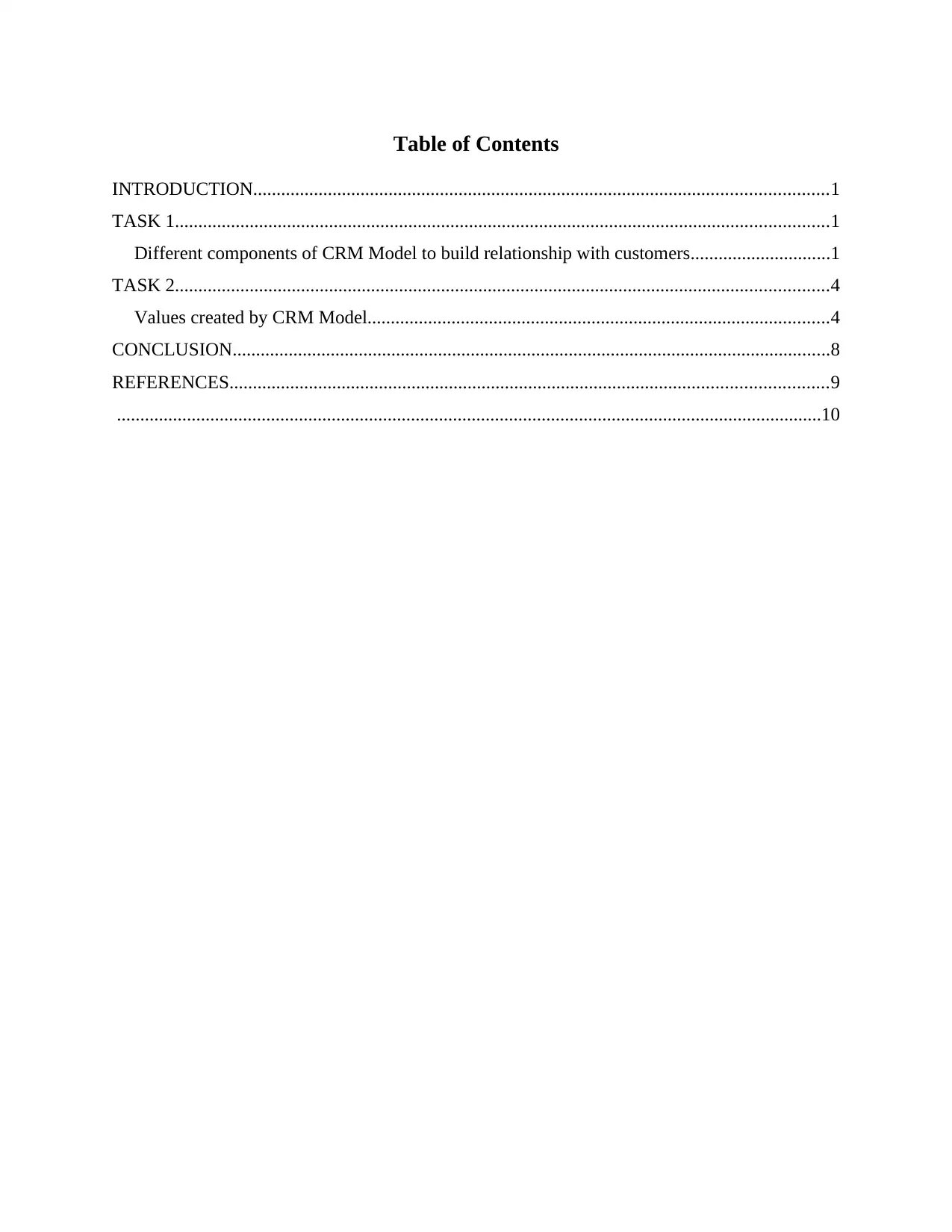
Table of Contents
INTRODUCTION...........................................................................................................................1
TASK 1............................................................................................................................................1
Different components of CRM Model to build relationship with customers..............................1
TASK 2............................................................................................................................................4
Values created by CRM Model...................................................................................................4
CONCLUSION................................................................................................................................8
REFERENCES................................................................................................................................9
.......................................................................................................................................................10
INTRODUCTION...........................................................................................................................1
TASK 1............................................................................................................................................1
Different components of CRM Model to build relationship with customers..............................1
TASK 2............................................................................................................................................4
Values created by CRM Model...................................................................................................4
CONCLUSION................................................................................................................................8
REFERENCES................................................................................................................................9
.......................................................................................................................................................10
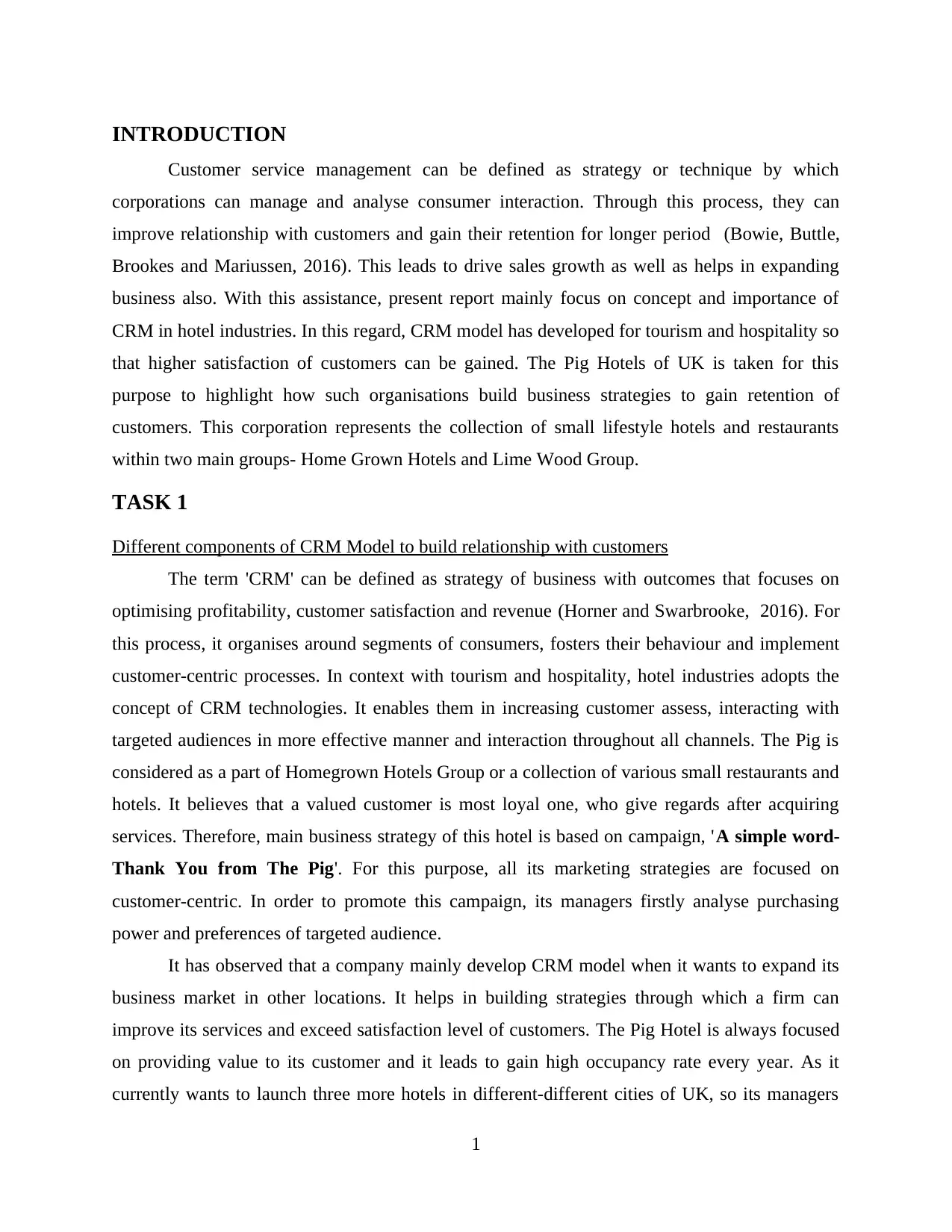
INTRODUCTION
Customer service management can be defined as strategy or technique by which
corporations can manage and analyse consumer interaction. Through this process, they can
improve relationship with customers and gain their retention for longer period (Bowie, Buttle,
Brookes and Mariussen, 2016). This leads to drive sales growth as well as helps in expanding
business also. With this assistance, present report mainly focus on concept and importance of
CRM in hotel industries. In this regard, CRM model has developed for tourism and hospitality so
that higher satisfaction of customers can be gained. The Pig Hotels of UK is taken for this
purpose to highlight how such organisations build business strategies to gain retention of
customers. This corporation represents the collection of small lifestyle hotels and restaurants
within two main groups- Home Grown Hotels and Lime Wood Group.
TASK 1
Different components of CRM Model to build relationship with customers
The term 'CRM' can be defined as strategy of business with outcomes that focuses on
optimising profitability, customer satisfaction and revenue (Horner and Swarbrooke, 2016). For
this process, it organises around segments of consumers, fosters their behaviour and implement
customer-centric processes. In context with tourism and hospitality, hotel industries adopts the
concept of CRM technologies. It enables them in increasing customer assess, interacting with
targeted audiences in more effective manner and interaction throughout all channels. The Pig is
considered as a part of Homegrown Hotels Group or a collection of various small restaurants and
hotels. It believes that a valued customer is most loyal one, who give regards after acquiring
services. Therefore, main business strategy of this hotel is based on campaign, 'A simple word-
Thank You from The Pig'. For this purpose, all its marketing strategies are focused on
customer-centric. In order to promote this campaign, its managers firstly analyse purchasing
power and preferences of targeted audience.
It has observed that a company mainly develop CRM model when it wants to expand its
business market in other locations. It helps in building strategies through which a firm can
improve its services and exceed satisfaction level of customers. The Pig Hotel is always focused
on providing value to its customer and it leads to gain high occupancy rate every year. As it
currently wants to launch three more hotels in different-different cities of UK, so its managers
1
Customer service management can be defined as strategy or technique by which
corporations can manage and analyse consumer interaction. Through this process, they can
improve relationship with customers and gain their retention for longer period (Bowie, Buttle,
Brookes and Mariussen, 2016). This leads to drive sales growth as well as helps in expanding
business also. With this assistance, present report mainly focus on concept and importance of
CRM in hotel industries. In this regard, CRM model has developed for tourism and hospitality so
that higher satisfaction of customers can be gained. The Pig Hotels of UK is taken for this
purpose to highlight how such organisations build business strategies to gain retention of
customers. This corporation represents the collection of small lifestyle hotels and restaurants
within two main groups- Home Grown Hotels and Lime Wood Group.
TASK 1
Different components of CRM Model to build relationship with customers
The term 'CRM' can be defined as strategy of business with outcomes that focuses on
optimising profitability, customer satisfaction and revenue (Horner and Swarbrooke, 2016). For
this process, it organises around segments of consumers, fosters their behaviour and implement
customer-centric processes. In context with tourism and hospitality, hotel industries adopts the
concept of CRM technologies. It enables them in increasing customer assess, interacting with
targeted audiences in more effective manner and interaction throughout all channels. The Pig is
considered as a part of Homegrown Hotels Group or a collection of various small restaurants and
hotels. It believes that a valued customer is most loyal one, who give regards after acquiring
services. Therefore, main business strategy of this hotel is based on campaign, 'A simple word-
Thank You from The Pig'. For this purpose, all its marketing strategies are focused on
customer-centric. In order to promote this campaign, its managers firstly analyse purchasing
power and preferences of targeted audience.
It has observed that a company mainly develop CRM model when it wants to expand its
business market in other locations. It helps in building strategies through which a firm can
improve its services and exceed satisfaction level of customers. The Pig Hotel is always focused
on providing value to its customer and it leads to gain high occupancy rate every year. As it
currently wants to launch three more hotels in different-different cities of UK, so its managers
1
⊘ This is a preview!⊘
Do you want full access?
Subscribe today to unlock all pages.

Trusted by 1+ million students worldwide
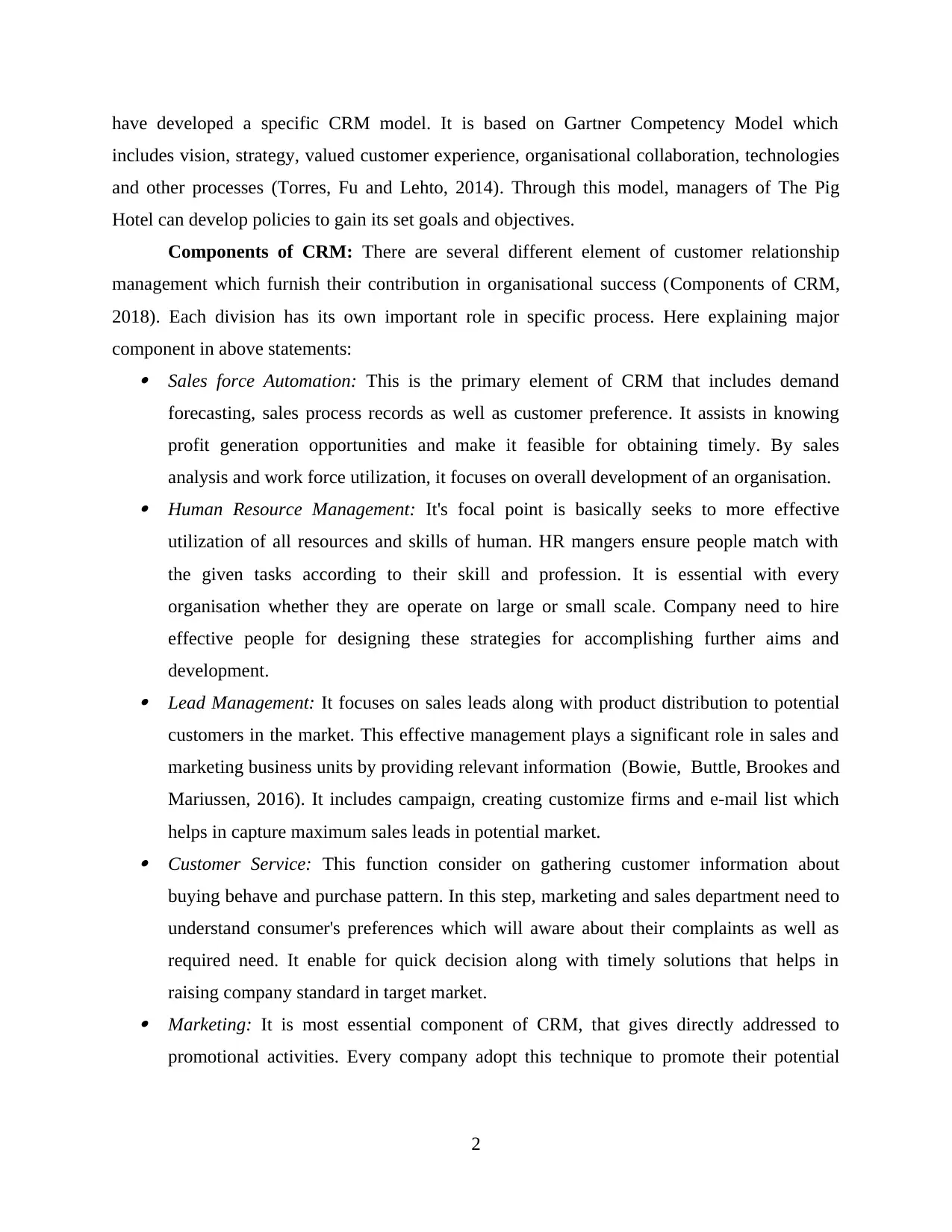
have developed a specific CRM model. It is based on Gartner Competency Model which
includes vision, strategy, valued customer experience, organisational collaboration, technologies
and other processes (Torres, Fu and Lehto, 2014). Through this model, managers of The Pig
Hotel can develop policies to gain its set goals and objectives.
Components of CRM: There are several different element of customer relationship
management which furnish their contribution in organisational success (Components of CRM,
2018). Each division has its own important role in specific process. Here explaining major
component in above statements: Sales force Automation: This is the primary element of CRM that includes demand
forecasting, sales process records as well as customer preference. It assists in knowing
profit generation opportunities and make it feasible for obtaining timely. By sales
analysis and work force utilization, it focuses on overall development of an organisation. Human Resource Management: It's focal point is basically seeks to more effective
utilization of all resources and skills of human. HR mangers ensure people match with
the given tasks according to their skill and profession. It is essential with every
organisation whether they are operate on large or small scale. Company need to hire
effective people for designing these strategies for accomplishing further aims and
development. Lead Management: It focuses on sales leads along with product distribution to potential
customers in the market. This effective management plays a significant role in sales and
marketing business units by providing relevant information (Bowie, Buttle, Brookes and
Mariussen, 2016). It includes campaign, creating customize firms and e-mail list which
helps in capture maximum sales leads in potential market. Customer Service: This function consider on gathering customer information about
buying behave and purchase pattern. In this step, marketing and sales department need to
understand consumer's preferences which will aware about their complaints as well as
required need. It enable for quick decision along with timely solutions that helps in
raising company standard in target market. Marketing: It is most essential component of CRM, that gives directly addressed to
promotional activities. Every company adopt this technique to promote their potential
2
includes vision, strategy, valued customer experience, organisational collaboration, technologies
and other processes (Torres, Fu and Lehto, 2014). Through this model, managers of The Pig
Hotel can develop policies to gain its set goals and objectives.
Components of CRM: There are several different element of customer relationship
management which furnish their contribution in organisational success (Components of CRM,
2018). Each division has its own important role in specific process. Here explaining major
component in above statements: Sales force Automation: This is the primary element of CRM that includes demand
forecasting, sales process records as well as customer preference. It assists in knowing
profit generation opportunities and make it feasible for obtaining timely. By sales
analysis and work force utilization, it focuses on overall development of an organisation. Human Resource Management: It's focal point is basically seeks to more effective
utilization of all resources and skills of human. HR mangers ensure people match with
the given tasks according to their skill and profession. It is essential with every
organisation whether they are operate on large or small scale. Company need to hire
effective people for designing these strategies for accomplishing further aims and
development. Lead Management: It focuses on sales leads along with product distribution to potential
customers in the market. This effective management plays a significant role in sales and
marketing business units by providing relevant information (Bowie, Buttle, Brookes and
Mariussen, 2016). It includes campaign, creating customize firms and e-mail list which
helps in capture maximum sales leads in potential market. Customer Service: This function consider on gathering customer information about
buying behave and purchase pattern. In this step, marketing and sales department need to
understand consumer's preferences which will aware about their complaints as well as
required need. It enable for quick decision along with timely solutions that helps in
raising company standard in target market. Marketing: It is most essential component of CRM, that gives directly addressed to
promotional activities. Every company adopt this technique to promote their potential
2
Paraphrase This Document
Need a fresh take? Get an instant paraphrase of this document with our AI Paraphraser
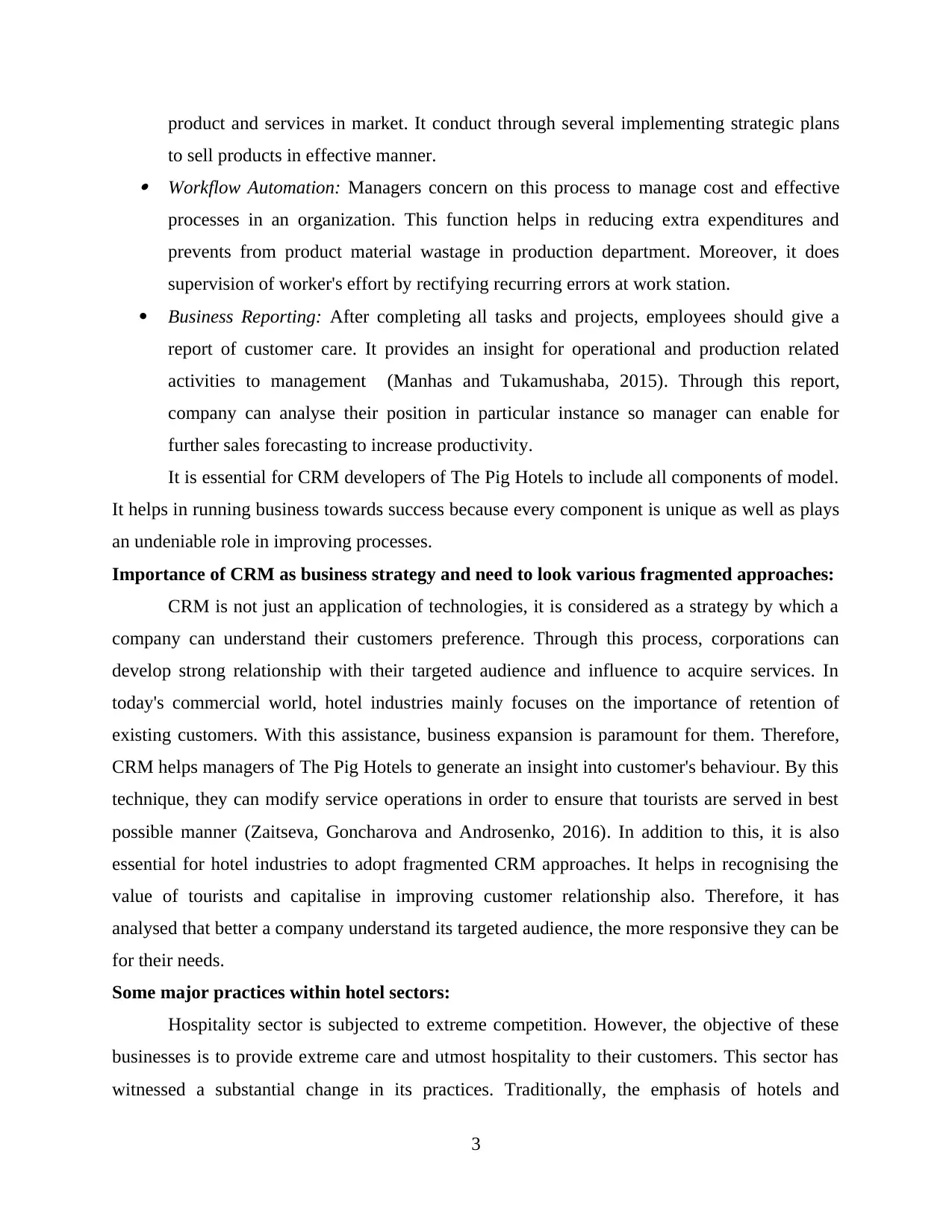
product and services in market. It conduct through several implementing strategic plans
to sell products in effective manner. Workflow Automation: Managers concern on this process to manage cost and effective
processes in an organization. This function helps in reducing extra expenditures and
prevents from product material wastage in production department. Moreover, it does
supervision of worker's effort by rectifying recurring errors at work station.
Business Reporting: After completing all tasks and projects, employees should give a
report of customer care. It provides an insight for operational and production related
activities to management (Manhas and Tukamushaba, 2015). Through this report,
company can analyse their position in particular instance so manager can enable for
further sales forecasting to increase productivity.
It is essential for CRM developers of The Pig Hotels to include all components of model.
It helps in running business towards success because every component is unique as well as plays
an undeniable role in improving processes.
Importance of CRM as business strategy and need to look various fragmented approaches:
CRM is not just an application of technologies, it is considered as a strategy by which a
company can understand their customers preference. Through this process, corporations can
develop strong relationship with their targeted audience and influence to acquire services. In
today's commercial world, hotel industries mainly focuses on the importance of retention of
existing customers. With this assistance, business expansion is paramount for them. Therefore,
CRM helps managers of The Pig Hotels to generate an insight into customer's behaviour. By this
technique, they can modify service operations in order to ensure that tourists are served in best
possible manner (Zaitseva, Goncharova and Androsenko, 2016). In addition to this, it is also
essential for hotel industries to adopt fragmented CRM approaches. It helps in recognising the
value of tourists and capitalise in improving customer relationship also. Therefore, it has
analysed that better a company understand its targeted audience, the more responsive they can be
for their needs.
Some major practices within hotel sectors:
Hospitality sector is subjected to extreme competition. However, the objective of these
businesses is to provide extreme care and utmost hospitality to their customers. This sector has
witnessed a substantial change in its practices. Traditionally, the emphasis of hotels and
3
to sell products in effective manner. Workflow Automation: Managers concern on this process to manage cost and effective
processes in an organization. This function helps in reducing extra expenditures and
prevents from product material wastage in production department. Moreover, it does
supervision of worker's effort by rectifying recurring errors at work station.
Business Reporting: After completing all tasks and projects, employees should give a
report of customer care. It provides an insight for operational and production related
activities to management (Manhas and Tukamushaba, 2015). Through this report,
company can analyse their position in particular instance so manager can enable for
further sales forecasting to increase productivity.
It is essential for CRM developers of The Pig Hotels to include all components of model.
It helps in running business towards success because every component is unique as well as plays
an undeniable role in improving processes.
Importance of CRM as business strategy and need to look various fragmented approaches:
CRM is not just an application of technologies, it is considered as a strategy by which a
company can understand their customers preference. Through this process, corporations can
develop strong relationship with their targeted audience and influence to acquire services. In
today's commercial world, hotel industries mainly focuses on the importance of retention of
existing customers. With this assistance, business expansion is paramount for them. Therefore,
CRM helps managers of The Pig Hotels to generate an insight into customer's behaviour. By this
technique, they can modify service operations in order to ensure that tourists are served in best
possible manner (Zaitseva, Goncharova and Androsenko, 2016). In addition to this, it is also
essential for hotel industries to adopt fragmented CRM approaches. It helps in recognising the
value of tourists and capitalise in improving customer relationship also. Therefore, it has
analysed that better a company understand its targeted audience, the more responsive they can be
for their needs.
Some major practices within hotel sectors:
Hospitality sector is subjected to extreme competition. However, the objective of these
businesses is to provide extreme care and utmost hospitality to their customers. This sector has
witnessed a substantial change in its practices. Traditionally, the emphasis of hotels and
3
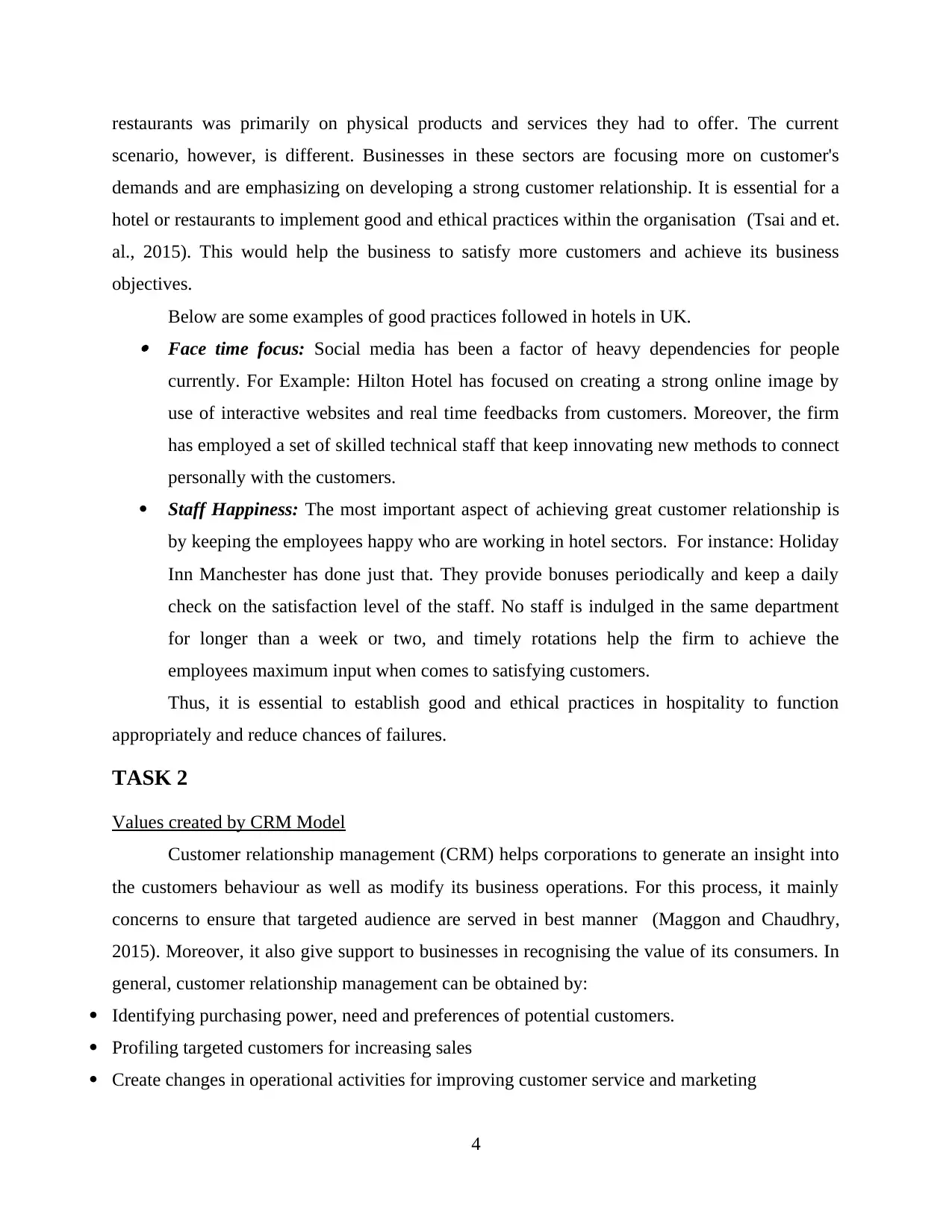
restaurants was primarily on physical products and services they had to offer. The current
scenario, however, is different. Businesses in these sectors are focusing more on customer's
demands and are emphasizing on developing a strong customer relationship. It is essential for a
hotel or restaurants to implement good and ethical practices within the organisation (Tsai and et.
al., 2015). This would help the business to satisfy more customers and achieve its business
objectives.
Below are some examples of good practices followed in hotels in UK. Face time focus: Social media has been a factor of heavy dependencies for people
currently. For Example: Hilton Hotel has focused on creating a strong online image by
use of interactive websites and real time feedbacks from customers. Moreover, the firm
has employed a set of skilled technical staff that keep innovating new methods to connect
personally with the customers.
Staff Happiness: The most important aspect of achieving great customer relationship is
by keeping the employees happy who are working in hotel sectors. For instance: Holiday
Inn Manchester has done just that. They provide bonuses periodically and keep a daily
check on the satisfaction level of the staff. No staff is indulged in the same department
for longer than a week or two, and timely rotations help the firm to achieve the
employees maximum input when comes to satisfying customers.
Thus, it is essential to establish good and ethical practices in hospitality to function
appropriately and reduce chances of failures.
TASK 2
Values created by CRM Model
Customer relationship management (CRM) helps corporations to generate an insight into
the customers behaviour as well as modify its business operations. For this process, it mainly
concerns to ensure that targeted audience are served in best manner (Maggon and Chaudhry,
2015). Moreover, it also give support to businesses in recognising the value of its consumers. In
general, customer relationship management can be obtained by:
Identifying purchasing power, need and preferences of potential customers.
Profiling targeted customers for increasing sales
Create changes in operational activities for improving customer service and marketing
4
scenario, however, is different. Businesses in these sectors are focusing more on customer's
demands and are emphasizing on developing a strong customer relationship. It is essential for a
hotel or restaurants to implement good and ethical practices within the organisation (Tsai and et.
al., 2015). This would help the business to satisfy more customers and achieve its business
objectives.
Below are some examples of good practices followed in hotels in UK. Face time focus: Social media has been a factor of heavy dependencies for people
currently. For Example: Hilton Hotel has focused on creating a strong online image by
use of interactive websites and real time feedbacks from customers. Moreover, the firm
has employed a set of skilled technical staff that keep innovating new methods to connect
personally with the customers.
Staff Happiness: The most important aspect of achieving great customer relationship is
by keeping the employees happy who are working in hotel sectors. For instance: Holiday
Inn Manchester has done just that. They provide bonuses periodically and keep a daily
check on the satisfaction level of the staff. No staff is indulged in the same department
for longer than a week or two, and timely rotations help the firm to achieve the
employees maximum input when comes to satisfying customers.
Thus, it is essential to establish good and ethical practices in hospitality to function
appropriately and reduce chances of failures.
TASK 2
Values created by CRM Model
Customer relationship management (CRM) helps corporations to generate an insight into
the customers behaviour as well as modify its business operations. For this process, it mainly
concerns to ensure that targeted audience are served in best manner (Maggon and Chaudhry,
2015). Moreover, it also give support to businesses in recognising the value of its consumers. In
general, customer relationship management can be obtained by:
Identifying purchasing power, need and preferences of potential customers.
Profiling targeted customers for increasing sales
Create changes in operational activities for improving customer service and marketing
4
⊘ This is a preview!⊘
Do you want full access?
Subscribe today to unlock all pages.

Trusted by 1+ million students worldwide
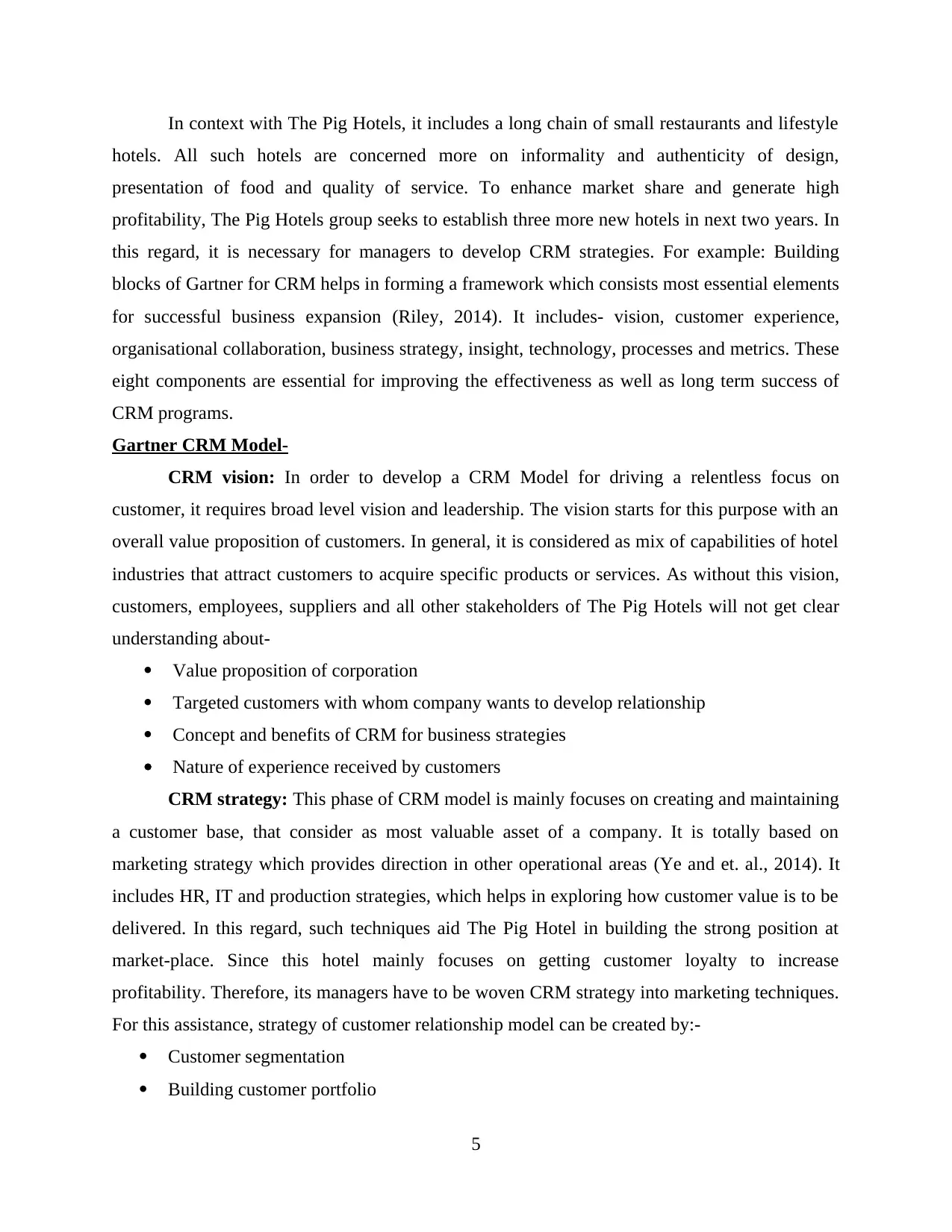
In context with The Pig Hotels, it includes a long chain of small restaurants and lifestyle
hotels. All such hotels are concerned more on informality and authenticity of design,
presentation of food and quality of service. To enhance market share and generate high
profitability, The Pig Hotels group seeks to establish three more new hotels in next two years. In
this regard, it is necessary for managers to develop CRM strategies. For example: Building
blocks of Gartner for CRM helps in forming a framework which consists most essential elements
for successful business expansion (Riley, 2014). It includes- vision, customer experience,
organisational collaboration, business strategy, insight, technology, processes and metrics. These
eight components are essential for improving the effectiveness as well as long term success of
CRM programs.
Gartner CRM Model-
CRM vision: In order to develop a CRM Model for driving a relentless focus on
customer, it requires broad level vision and leadership. The vision starts for this purpose with an
overall value proposition of customers. In general, it is considered as mix of capabilities of hotel
industries that attract customers to acquire specific products or services. As without this vision,
customers, employees, suppliers and all other stakeholders of The Pig Hotels will not get clear
understanding about-
Value proposition of corporation
Targeted customers with whom company wants to develop relationship
Concept and benefits of CRM for business strategies
Nature of experience received by customers
CRM strategy: This phase of CRM model is mainly focuses on creating and maintaining
a customer base, that consider as most valuable asset of a company. It is totally based on
marketing strategy which provides direction in other operational areas (Ye and et. al., 2014). It
includes HR, IT and production strategies, which helps in exploring how customer value is to be
delivered. In this regard, such techniques aid The Pig Hotel in building the strong position at
market-place. Since this hotel mainly focuses on getting customer loyalty to increase
profitability. Therefore, its managers have to be woven CRM strategy into marketing techniques.
For this assistance, strategy of customer relationship model can be created by:-
Customer segmentation
Building customer portfolio
5
hotels. All such hotels are concerned more on informality and authenticity of design,
presentation of food and quality of service. To enhance market share and generate high
profitability, The Pig Hotels group seeks to establish three more new hotels in next two years. In
this regard, it is necessary for managers to develop CRM strategies. For example: Building
blocks of Gartner for CRM helps in forming a framework which consists most essential elements
for successful business expansion (Riley, 2014). It includes- vision, customer experience,
organisational collaboration, business strategy, insight, technology, processes and metrics. These
eight components are essential for improving the effectiveness as well as long term success of
CRM programs.
Gartner CRM Model-
CRM vision: In order to develop a CRM Model for driving a relentless focus on
customer, it requires broad level vision and leadership. The vision starts for this purpose with an
overall value proposition of customers. In general, it is considered as mix of capabilities of hotel
industries that attract customers to acquire specific products or services. As without this vision,
customers, employees, suppliers and all other stakeholders of The Pig Hotels will not get clear
understanding about-
Value proposition of corporation
Targeted customers with whom company wants to develop relationship
Concept and benefits of CRM for business strategies
Nature of experience received by customers
CRM strategy: This phase of CRM model is mainly focuses on creating and maintaining
a customer base, that consider as most valuable asset of a company. It is totally based on
marketing strategy which provides direction in other operational areas (Ye and et. al., 2014). It
includes HR, IT and production strategies, which helps in exploring how customer value is to be
delivered. In this regard, such techniques aid The Pig Hotel in building the strong position at
market-place. Since this hotel mainly focuses on getting customer loyalty to increase
profitability. Therefore, its managers have to be woven CRM strategy into marketing techniques.
For this assistance, strategy of customer relationship model can be created by:-
Customer segmentation
Building customer portfolio
5
Paraphrase This Document
Need a fresh take? Get an instant paraphrase of this document with our AI Paraphraser
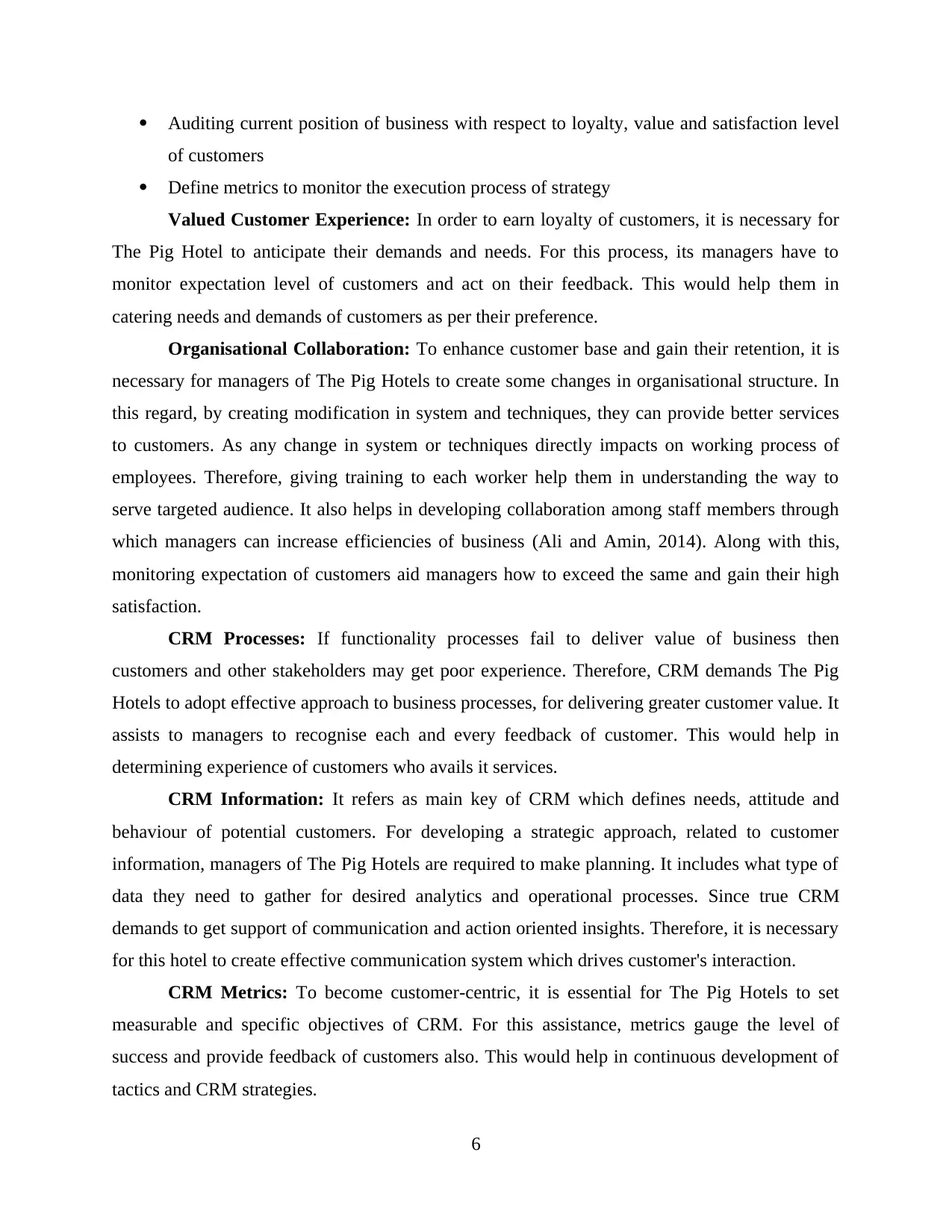
Auditing current position of business with respect to loyalty, value and satisfaction level
of customers
Define metrics to monitor the execution process of strategy
Valued Customer Experience: In order to earn loyalty of customers, it is necessary for
The Pig Hotel to anticipate their demands and needs. For this process, its managers have to
monitor expectation level of customers and act on their feedback. This would help them in
catering needs and demands of customers as per their preference.
Organisational Collaboration: To enhance customer base and gain their retention, it is
necessary for managers of The Pig Hotels to create some changes in organisational structure. In
this regard, by creating modification in system and techniques, they can provide better services
to customers. As any change in system or techniques directly impacts on working process of
employees. Therefore, giving training to each worker help them in understanding the way to
serve targeted audience. It also helps in developing collaboration among staff members through
which managers can increase efficiencies of business (Ali and Amin, 2014). Along with this,
monitoring expectation of customers aid managers how to exceed the same and gain their high
satisfaction.
CRM Processes: If functionality processes fail to deliver value of business then
customers and other stakeholders may get poor experience. Therefore, CRM demands The Pig
Hotels to adopt effective approach to business processes, for delivering greater customer value. It
assists to managers to recognise each and every feedback of customer. This would help in
determining experience of customers who avails it services.
CRM Information: It refers as main key of CRM which defines needs, attitude and
behaviour of potential customers. For developing a strategic approach, related to customer
information, managers of The Pig Hotels are required to make planning. It includes what type of
data they need to gather for desired analytics and operational processes. Since true CRM
demands to get support of communication and action oriented insights. Therefore, it is necessary
for this hotel to create effective communication system which drives customer's interaction.
CRM Metrics: To become customer-centric, it is essential for The Pig Hotels to set
measurable and specific objectives of CRM. For this assistance, metrics gauge the level of
success and provide feedback of customers also. This would help in continuous development of
tactics and CRM strategies.
6
of customers
Define metrics to monitor the execution process of strategy
Valued Customer Experience: In order to earn loyalty of customers, it is necessary for
The Pig Hotel to anticipate their demands and needs. For this process, its managers have to
monitor expectation level of customers and act on their feedback. This would help them in
catering needs and demands of customers as per their preference.
Organisational Collaboration: To enhance customer base and gain their retention, it is
necessary for managers of The Pig Hotels to create some changes in organisational structure. In
this regard, by creating modification in system and techniques, they can provide better services
to customers. As any change in system or techniques directly impacts on working process of
employees. Therefore, giving training to each worker help them in understanding the way to
serve targeted audience. It also helps in developing collaboration among staff members through
which managers can increase efficiencies of business (Ali and Amin, 2014). Along with this,
monitoring expectation of customers aid managers how to exceed the same and gain their high
satisfaction.
CRM Processes: If functionality processes fail to deliver value of business then
customers and other stakeholders may get poor experience. Therefore, CRM demands The Pig
Hotels to adopt effective approach to business processes, for delivering greater customer value. It
assists to managers to recognise each and every feedback of customer. This would help in
determining experience of customers who avails it services.
CRM Information: It refers as main key of CRM which defines needs, attitude and
behaviour of potential customers. For developing a strategic approach, related to customer
information, managers of The Pig Hotels are required to make planning. It includes what type of
data they need to gather for desired analytics and operational processes. Since true CRM
demands to get support of communication and action oriented insights. Therefore, it is necessary
for this hotel to create effective communication system which drives customer's interaction.
CRM Metrics: To become customer-centric, it is essential for The Pig Hotels to set
measurable and specific objectives of CRM. For this assistance, metrics gauge the level of
success and provide feedback of customers also. This would help in continuous development of
tactics and CRM strategies.
6
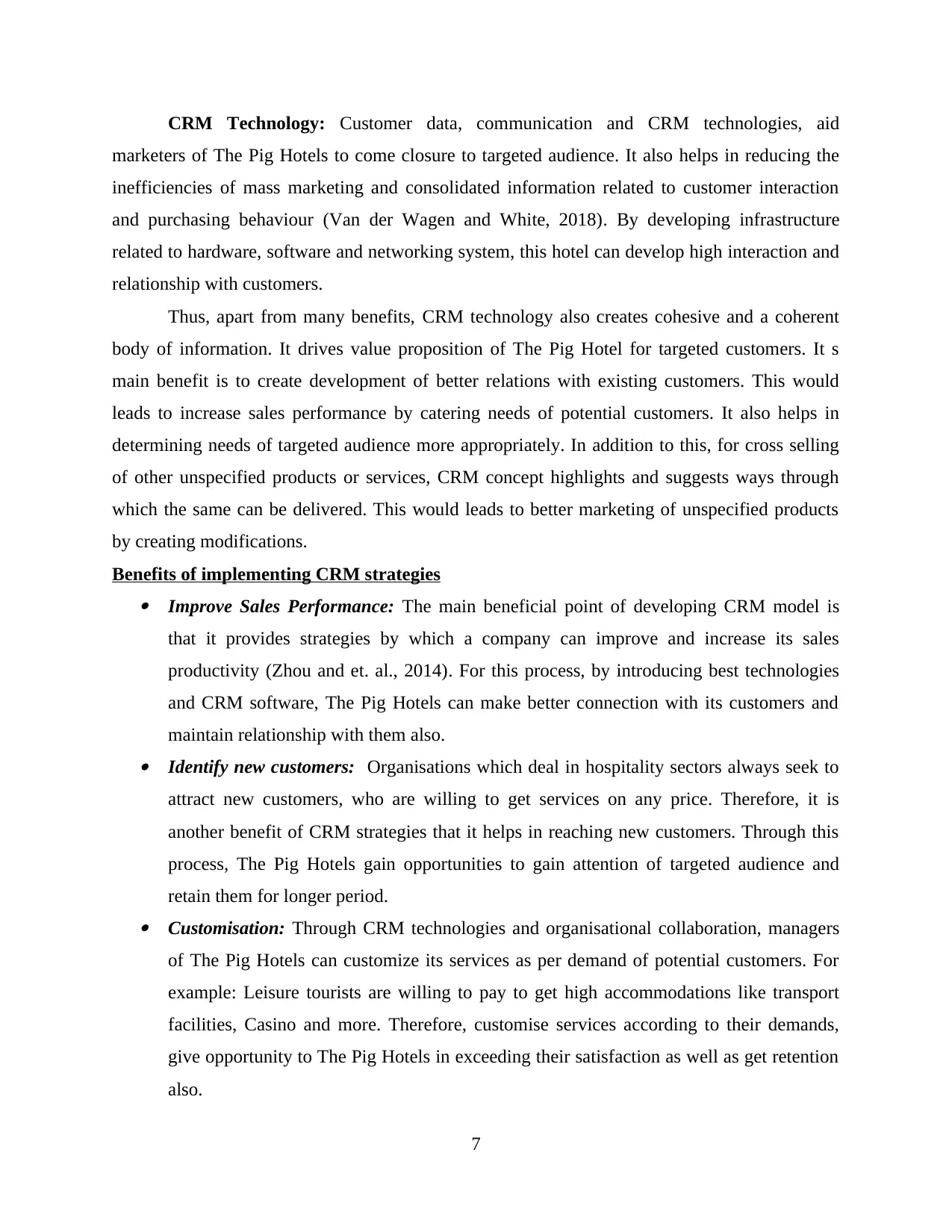
CRM Technology: Customer data, communication and CRM technologies, aid
marketers of The Pig Hotels to come closure to targeted audience. It also helps in reducing the
inefficiencies of mass marketing and consolidated information related to customer interaction
and purchasing behaviour (Van der Wagen and White, 2018). By developing infrastructure
related to hardware, software and networking system, this hotel can develop high interaction and
relationship with customers.
Thus, apart from many benefits, CRM technology also creates cohesive and a coherent
body of information. It drives value proposition of The Pig Hotel for targeted customers. It s
main benefit is to create development of better relations with existing customers. This would
leads to increase sales performance by catering needs of potential customers. It also helps in
determining needs of targeted audience more appropriately. In addition to this, for cross selling
of other unspecified products or services, CRM concept highlights and suggests ways through
which the same can be delivered. This would leads to better marketing of unspecified products
by creating modifications.
Benefits of implementing CRM strategies Improve Sales Performance: The main beneficial point of developing CRM model is
that it provides strategies by which a company can improve and increase its sales
productivity (Zhou and et. al., 2014). For this process, by introducing best technologies
and CRM software, The Pig Hotels can make better connection with its customers and
maintain relationship with them also. Identify new customers: Organisations which deal in hospitality sectors always seek to
attract new customers, who are willing to get services on any price. Therefore, it is
another benefit of CRM strategies that it helps in reaching new customers. Through this
process, The Pig Hotels gain opportunities to gain attention of targeted audience and
retain them for longer period. Customisation: Through CRM technologies and organisational collaboration, managers
of The Pig Hotels can customize its services as per demand of potential customers. For
example: Leisure tourists are willing to pay to get high accommodations like transport
facilities, Casino and more. Therefore, customise services according to their demands,
give opportunity to The Pig Hotels in exceeding their satisfaction as well as get retention
also.
7
marketers of The Pig Hotels to come closure to targeted audience. It also helps in reducing the
inefficiencies of mass marketing and consolidated information related to customer interaction
and purchasing behaviour (Van der Wagen and White, 2018). By developing infrastructure
related to hardware, software and networking system, this hotel can develop high interaction and
relationship with customers.
Thus, apart from many benefits, CRM technology also creates cohesive and a coherent
body of information. It drives value proposition of The Pig Hotel for targeted customers. It s
main benefit is to create development of better relations with existing customers. This would
leads to increase sales performance by catering needs of potential customers. It also helps in
determining needs of targeted audience more appropriately. In addition to this, for cross selling
of other unspecified products or services, CRM concept highlights and suggests ways through
which the same can be delivered. This would leads to better marketing of unspecified products
by creating modifications.
Benefits of implementing CRM strategies Improve Sales Performance: The main beneficial point of developing CRM model is
that it provides strategies by which a company can improve and increase its sales
productivity (Zhou and et. al., 2014). For this process, by introducing best technologies
and CRM software, The Pig Hotels can make better connection with its customers and
maintain relationship with them also. Identify new customers: Organisations which deal in hospitality sectors always seek to
attract new customers, who are willing to get services on any price. Therefore, it is
another benefit of CRM strategies that it helps in reaching new customers. Through this
process, The Pig Hotels gain opportunities to gain attention of targeted audience and
retain them for longer period. Customisation: Through CRM technologies and organisational collaboration, managers
of The Pig Hotels can customize its services as per demand of potential customers. For
example: Leisure tourists are willing to pay to get high accommodations like transport
facilities, Casino and more. Therefore, customise services according to their demands,
give opportunity to The Pig Hotels in exceeding their satisfaction as well as get retention
also.
7
⊘ This is a preview!⊘
Do you want full access?
Subscribe today to unlock all pages.

Trusted by 1+ million students worldwide
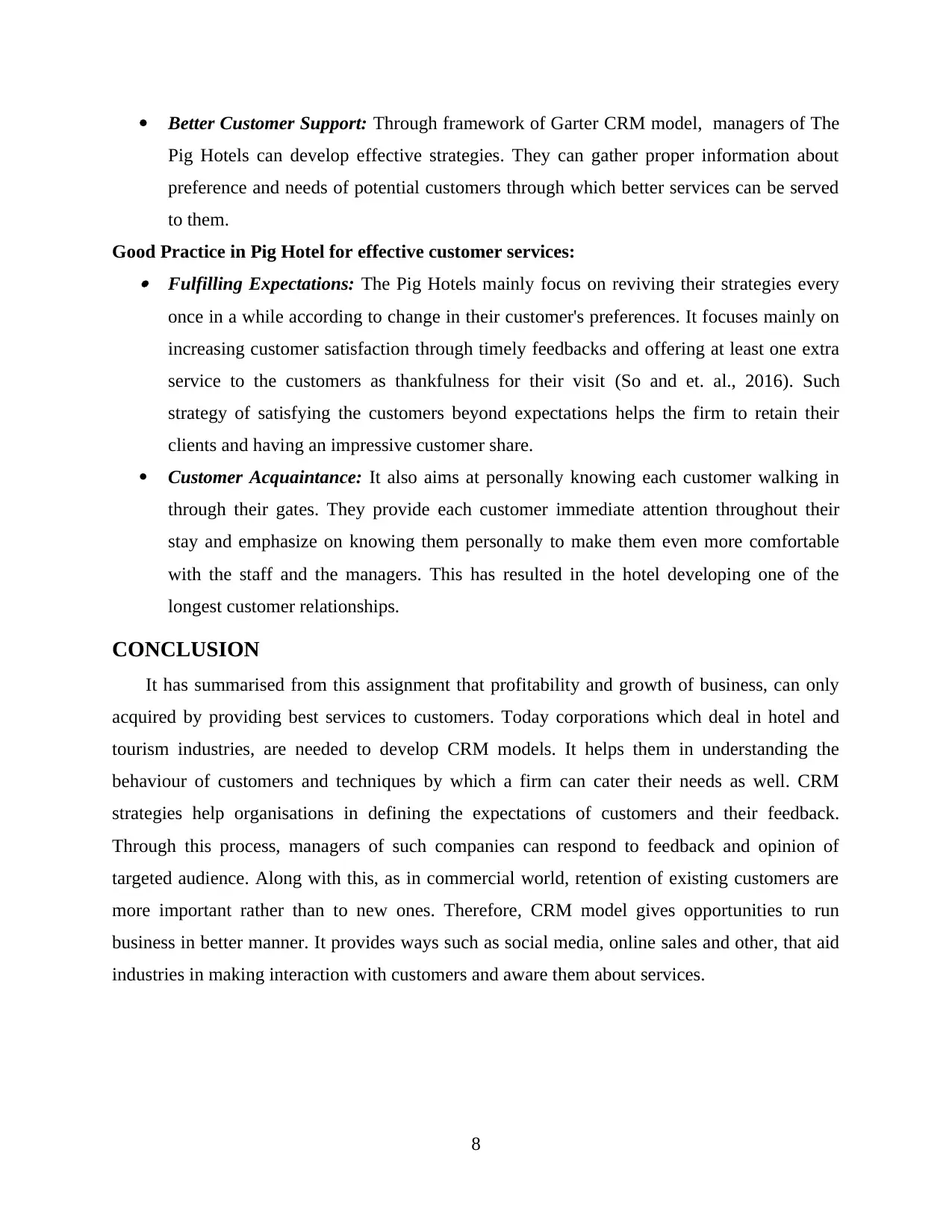
Better Customer Support: Through framework of Garter CRM model, managers of The
Pig Hotels can develop effective strategies. They can gather proper information about
preference and needs of potential customers through which better services can be served
to them.
Good Practice in Pig Hotel for effective customer services: Fulfilling Expectations: The Pig Hotels mainly focus on reviving their strategies every
once in a while according to change in their customer's preferences. It focuses mainly on
increasing customer satisfaction through timely feedbacks and offering at least one extra
service to the customers as thankfulness for their visit (So and et. al., 2016). Such
strategy of satisfying the customers beyond expectations helps the firm to retain their
clients and having an impressive customer share.
Customer Acquaintance: It also aims at personally knowing each customer walking in
through their gates. They provide each customer immediate attention throughout their
stay and emphasize on knowing them personally to make them even more comfortable
with the staff and the managers. This has resulted in the hotel developing one of the
longest customer relationships.
CONCLUSION
It has summarised from this assignment that profitability and growth of business, can only
acquired by providing best services to customers. Today corporations which deal in hotel and
tourism industries, are needed to develop CRM models. It helps them in understanding the
behaviour of customers and techniques by which a firm can cater their needs as well. CRM
strategies help organisations in defining the expectations of customers and their feedback.
Through this process, managers of such companies can respond to feedback and opinion of
targeted audience. Along with this, as in commercial world, retention of existing customers are
more important rather than to new ones. Therefore, CRM model gives opportunities to run
business in better manner. It provides ways such as social media, online sales and other, that aid
industries in making interaction with customers and aware them about services.
8
Pig Hotels can develop effective strategies. They can gather proper information about
preference and needs of potential customers through which better services can be served
to them.
Good Practice in Pig Hotel for effective customer services: Fulfilling Expectations: The Pig Hotels mainly focus on reviving their strategies every
once in a while according to change in their customer's preferences. It focuses mainly on
increasing customer satisfaction through timely feedbacks and offering at least one extra
service to the customers as thankfulness for their visit (So and et. al., 2016). Such
strategy of satisfying the customers beyond expectations helps the firm to retain their
clients and having an impressive customer share.
Customer Acquaintance: It also aims at personally knowing each customer walking in
through their gates. They provide each customer immediate attention throughout their
stay and emphasize on knowing them personally to make them even more comfortable
with the staff and the managers. This has resulted in the hotel developing one of the
longest customer relationships.
CONCLUSION
It has summarised from this assignment that profitability and growth of business, can only
acquired by providing best services to customers. Today corporations which deal in hotel and
tourism industries, are needed to develop CRM models. It helps them in understanding the
behaviour of customers and techniques by which a firm can cater their needs as well. CRM
strategies help organisations in defining the expectations of customers and their feedback.
Through this process, managers of such companies can respond to feedback and opinion of
targeted audience. Along with this, as in commercial world, retention of existing customers are
more important rather than to new ones. Therefore, CRM model gives opportunities to run
business in better manner. It provides ways such as social media, online sales and other, that aid
industries in making interaction with customers and aware them about services.
8
Paraphrase This Document
Need a fresh take? Get an instant paraphrase of this document with our AI Paraphraser
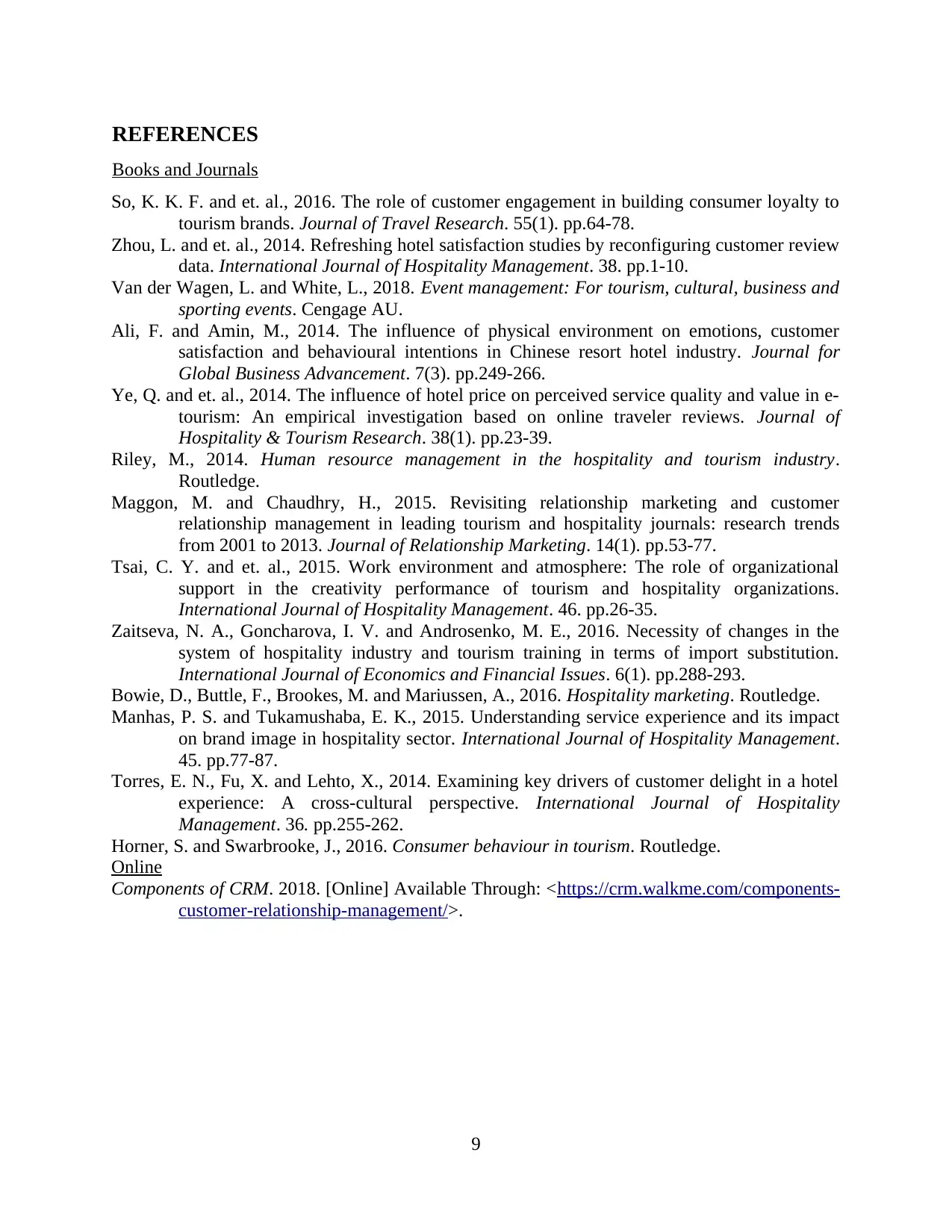
REFERENCES
Books and Journals
So, K. K. F. and et. al., 2016. The role of customer engagement in building consumer loyalty to
tourism brands. Journal of Travel Research. 55(1). pp.64-78.
Zhou, L. and et. al., 2014. Refreshing hotel satisfaction studies by reconfiguring customer review
data. International Journal of Hospitality Management. 38. pp.1-10.
Van der Wagen, L. and White, L., 2018. Event management: For tourism, cultural, business and
sporting events. Cengage AU.
Ali, F. and Amin, M., 2014. The influence of physical environment on emotions, customer
satisfaction and behavioural intentions in Chinese resort hotel industry. Journal for
Global Business Advancement. 7(3). pp.249-266.
Ye, Q. and et. al., 2014. The influence of hotel price on perceived service quality and value in e-
tourism: An empirical investigation based on online traveler reviews. Journal of
Hospitality & Tourism Research. 38(1). pp.23-39.
Riley, M., 2014. Human resource management in the hospitality and tourism industry.
Routledge.
Maggon, M. and Chaudhry, H., 2015. Revisiting relationship marketing and customer
relationship management in leading tourism and hospitality journals: research trends
from 2001 to 2013. Journal of Relationship Marketing. 14(1). pp.53-77.
Tsai, C. Y. and et. al., 2015. Work environment and atmosphere: The role of organizational
support in the creativity performance of tourism and hospitality organizations.
International Journal of Hospitality Management. 46. pp.26-35.
Zaitseva, N. A., Goncharova, I. V. and Androsenko, M. E., 2016. Necessity of changes in the
system of hospitality industry and tourism training in terms of import substitution.
International Journal of Economics and Financial Issues. 6(1). pp.288-293.
Bowie, D., Buttle, F., Brookes, M. and Mariussen, A., 2016. Hospitality marketing. Routledge.
Manhas, P. S. and Tukamushaba, E. K., 2015. Understanding service experience and its impact
on brand image in hospitality sector. International Journal of Hospitality Management.
45. pp.77-87.
Torres, E. N., Fu, X. and Lehto, X., 2014. Examining key drivers of customer delight in a hotel
experience: A cross-cultural perspective. International Journal of Hospitality
Management. 36. pp.255-262.
Horner, S. and Swarbrooke, J., 2016. Consumer behaviour in tourism. Routledge.
Online
Components of CRM. 2018. [Online] Available Through: <https://crm.walkme.com/components-
customer-relationship-management/>.
9
Books and Journals
So, K. K. F. and et. al., 2016. The role of customer engagement in building consumer loyalty to
tourism brands. Journal of Travel Research. 55(1). pp.64-78.
Zhou, L. and et. al., 2014. Refreshing hotel satisfaction studies by reconfiguring customer review
data. International Journal of Hospitality Management. 38. pp.1-10.
Van der Wagen, L. and White, L., 2018. Event management: For tourism, cultural, business and
sporting events. Cengage AU.
Ali, F. and Amin, M., 2014. The influence of physical environment on emotions, customer
satisfaction and behavioural intentions in Chinese resort hotel industry. Journal for
Global Business Advancement. 7(3). pp.249-266.
Ye, Q. and et. al., 2014. The influence of hotel price on perceived service quality and value in e-
tourism: An empirical investigation based on online traveler reviews. Journal of
Hospitality & Tourism Research. 38(1). pp.23-39.
Riley, M., 2014. Human resource management in the hospitality and tourism industry.
Routledge.
Maggon, M. and Chaudhry, H., 2015. Revisiting relationship marketing and customer
relationship management in leading tourism and hospitality journals: research trends
from 2001 to 2013. Journal of Relationship Marketing. 14(1). pp.53-77.
Tsai, C. Y. and et. al., 2015. Work environment and atmosphere: The role of organizational
support in the creativity performance of tourism and hospitality organizations.
International Journal of Hospitality Management. 46. pp.26-35.
Zaitseva, N. A., Goncharova, I. V. and Androsenko, M. E., 2016. Necessity of changes in the
system of hospitality industry and tourism training in terms of import substitution.
International Journal of Economics and Financial Issues. 6(1). pp.288-293.
Bowie, D., Buttle, F., Brookes, M. and Mariussen, A., 2016. Hospitality marketing. Routledge.
Manhas, P. S. and Tukamushaba, E. K., 2015. Understanding service experience and its impact
on brand image in hospitality sector. International Journal of Hospitality Management.
45. pp.77-87.
Torres, E. N., Fu, X. and Lehto, X., 2014. Examining key drivers of customer delight in a hotel
experience: A cross-cultural perspective. International Journal of Hospitality
Management. 36. pp.255-262.
Horner, S. and Swarbrooke, J., 2016. Consumer behaviour in tourism. Routledge.
Online
Components of CRM. 2018. [Online] Available Through: <https://crm.walkme.com/components-
customer-relationship-management/>.
9

10
⊘ This is a preview!⊘
Do you want full access?
Subscribe today to unlock all pages.

Trusted by 1+ million students worldwide
1 out of 12
Related Documents
Your All-in-One AI-Powered Toolkit for Academic Success.
+13062052269
info@desklib.com
Available 24*7 on WhatsApp / Email
![[object Object]](/_next/static/media/star-bottom.7253800d.svg)
Unlock your academic potential
Copyright © 2020–2025 A2Z Services. All Rights Reserved. Developed and managed by ZUCOL.




